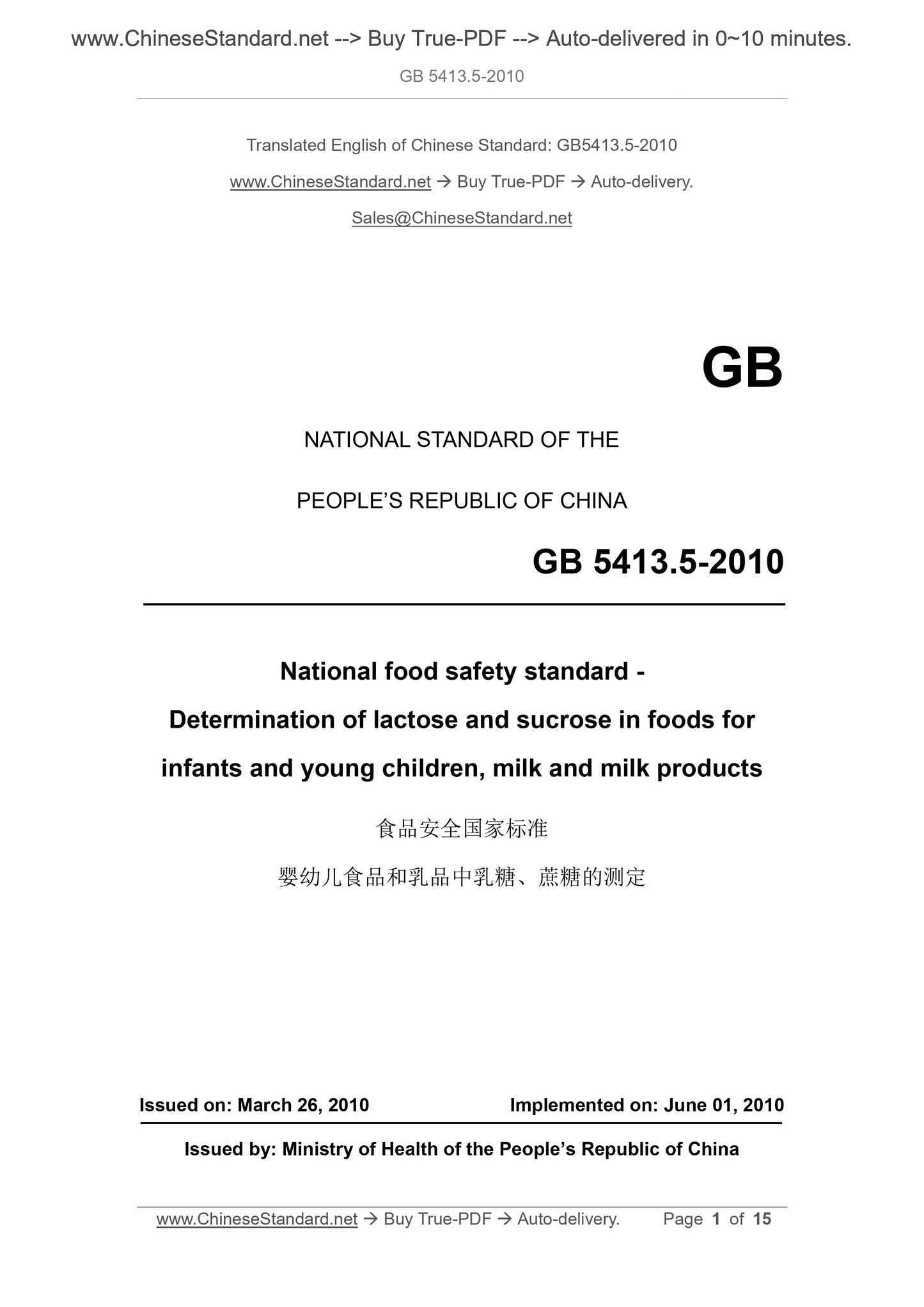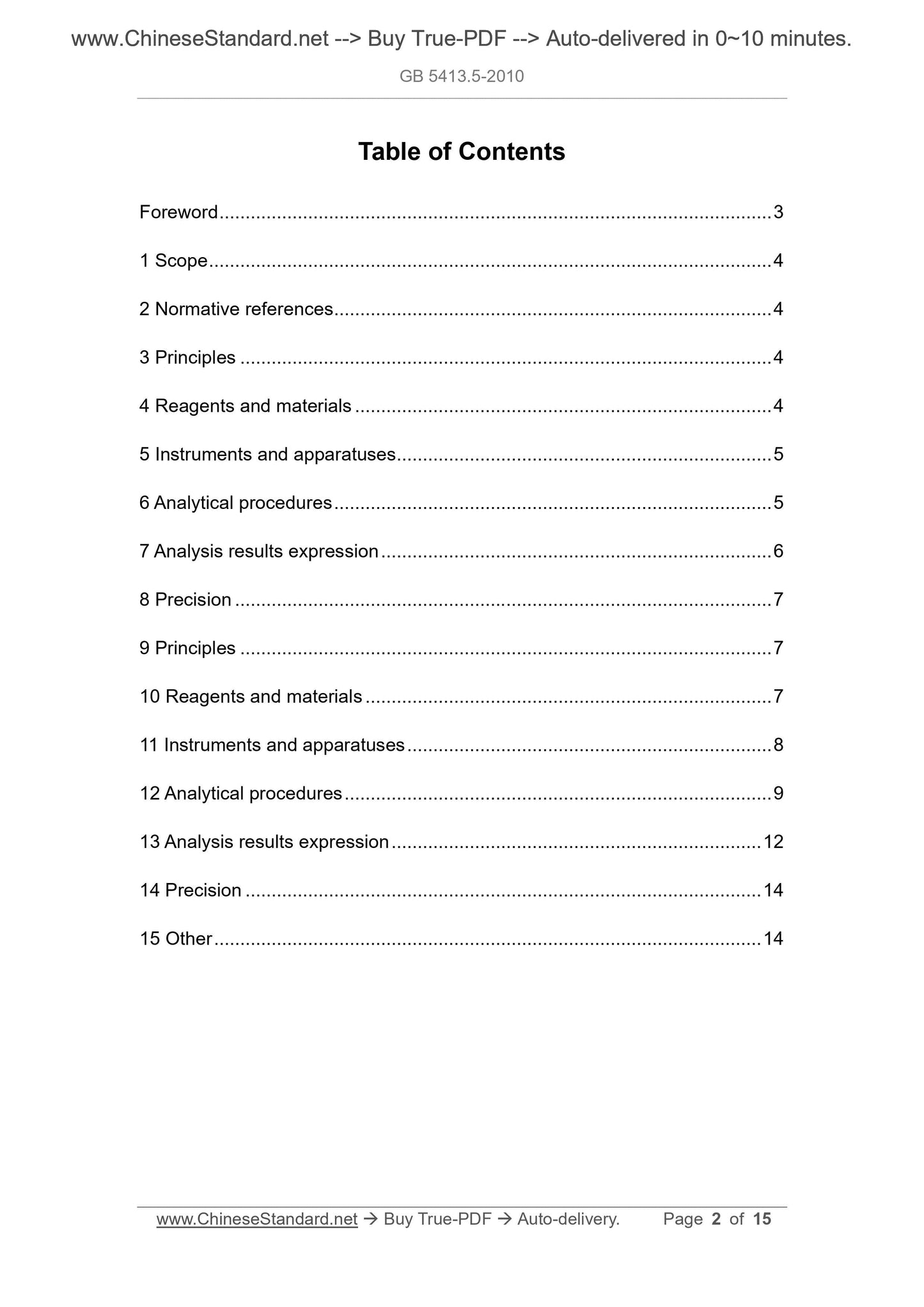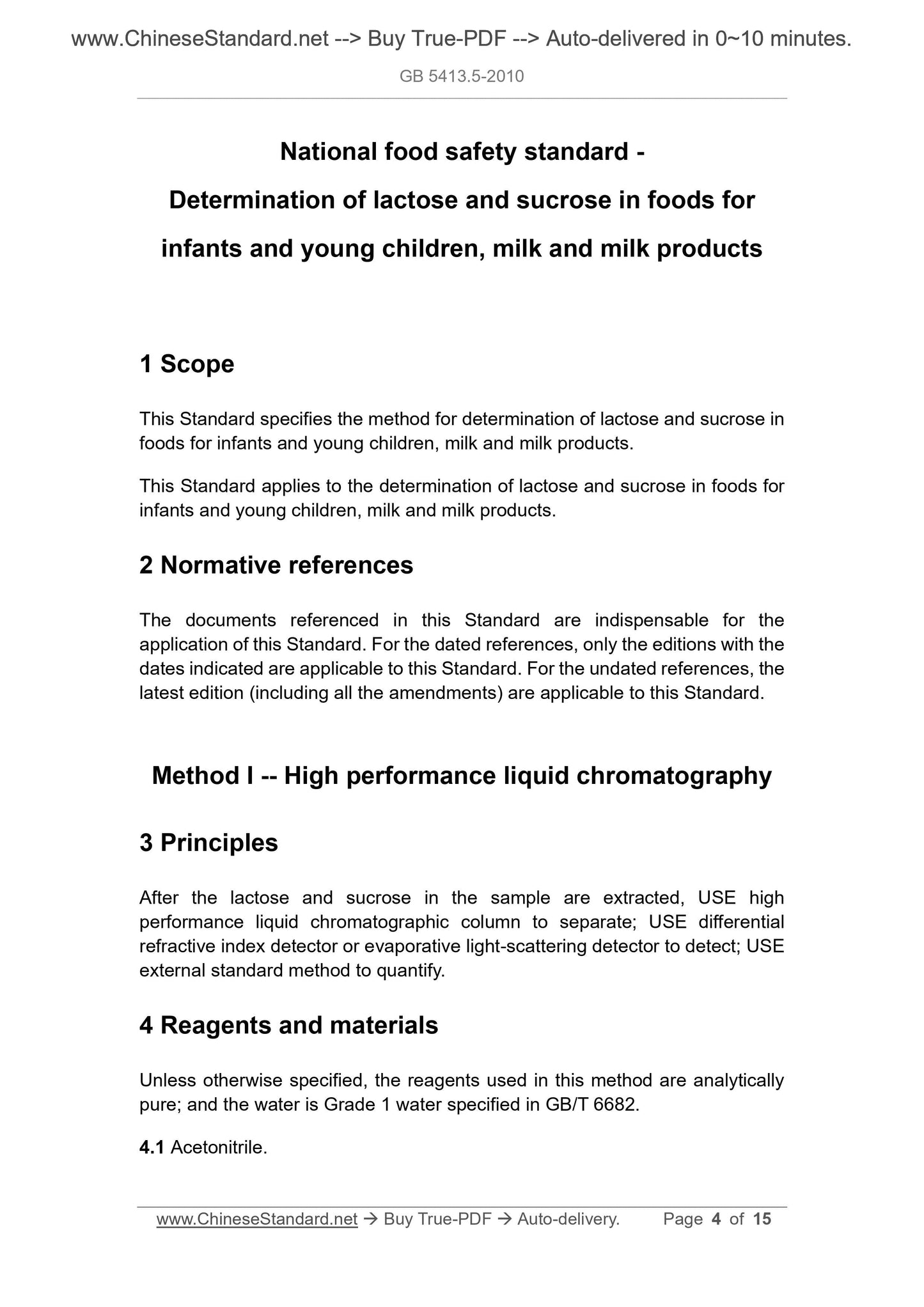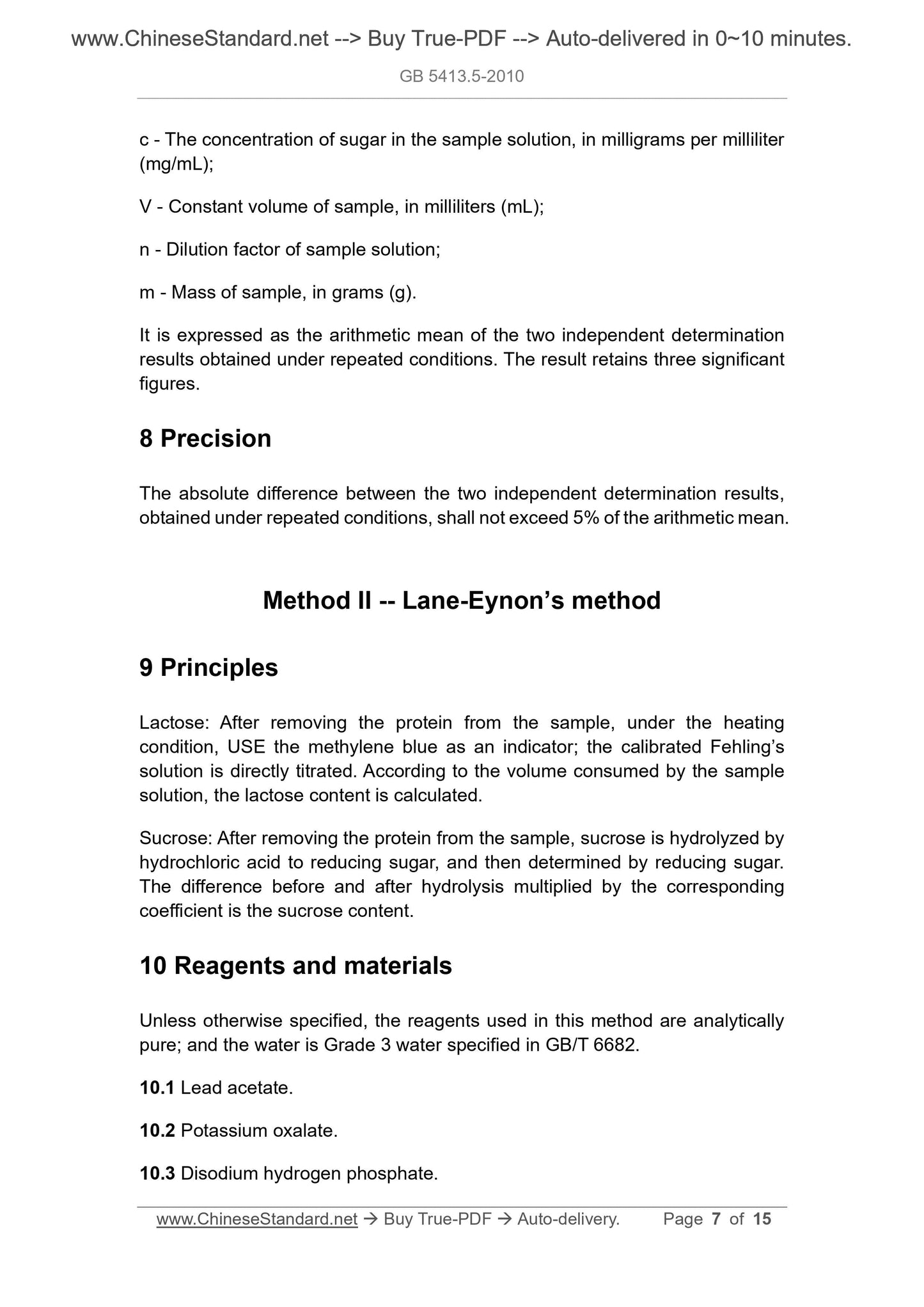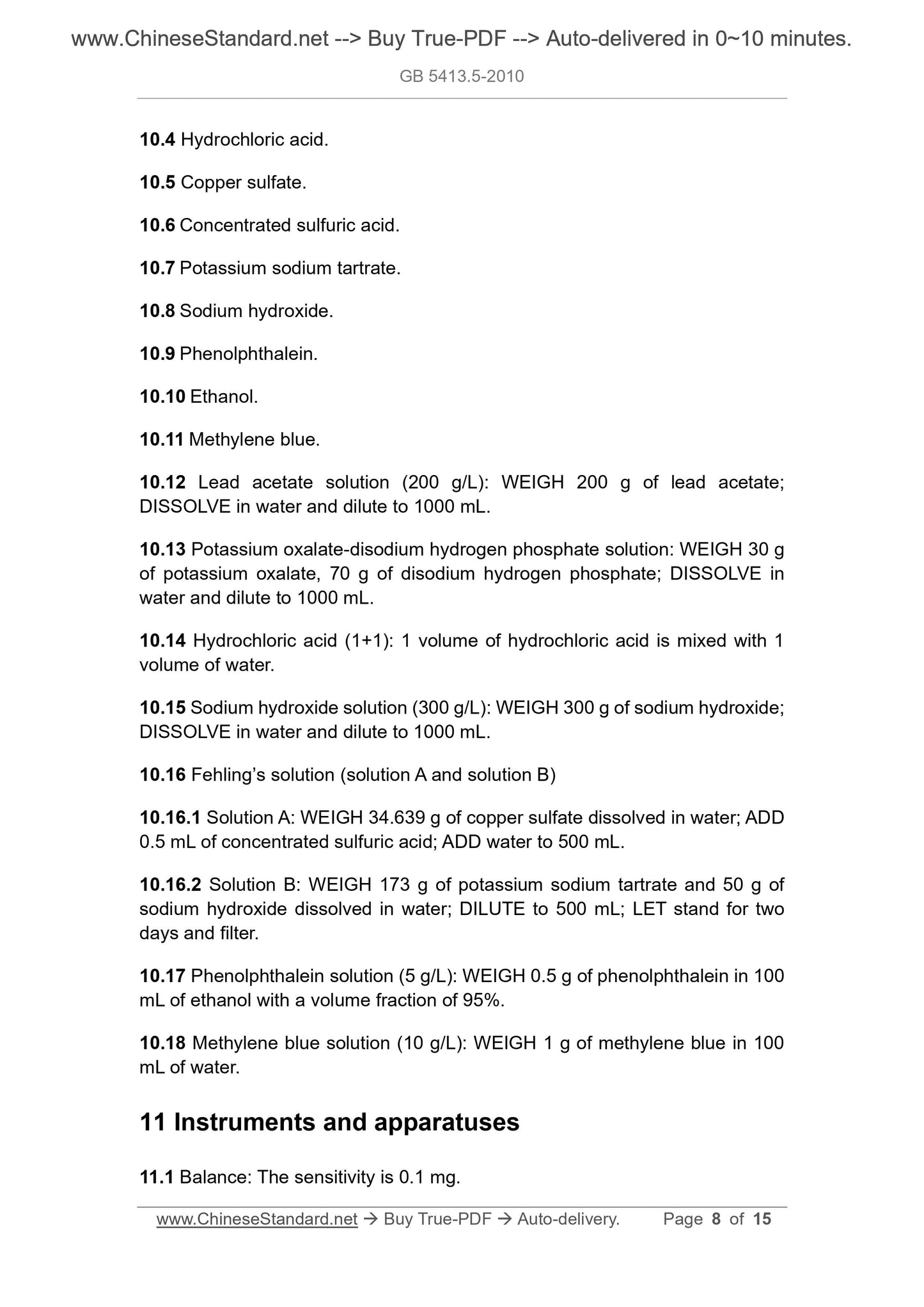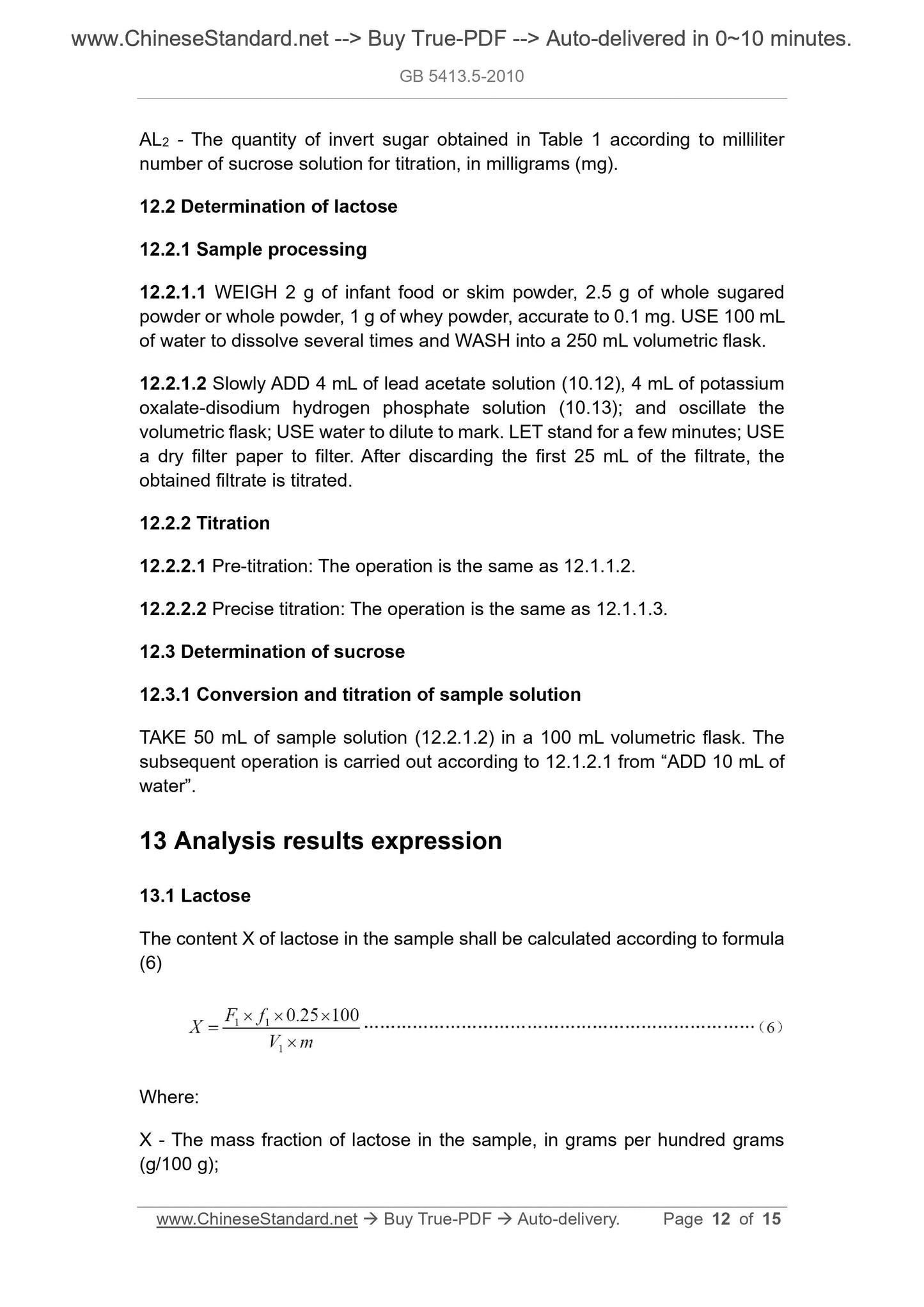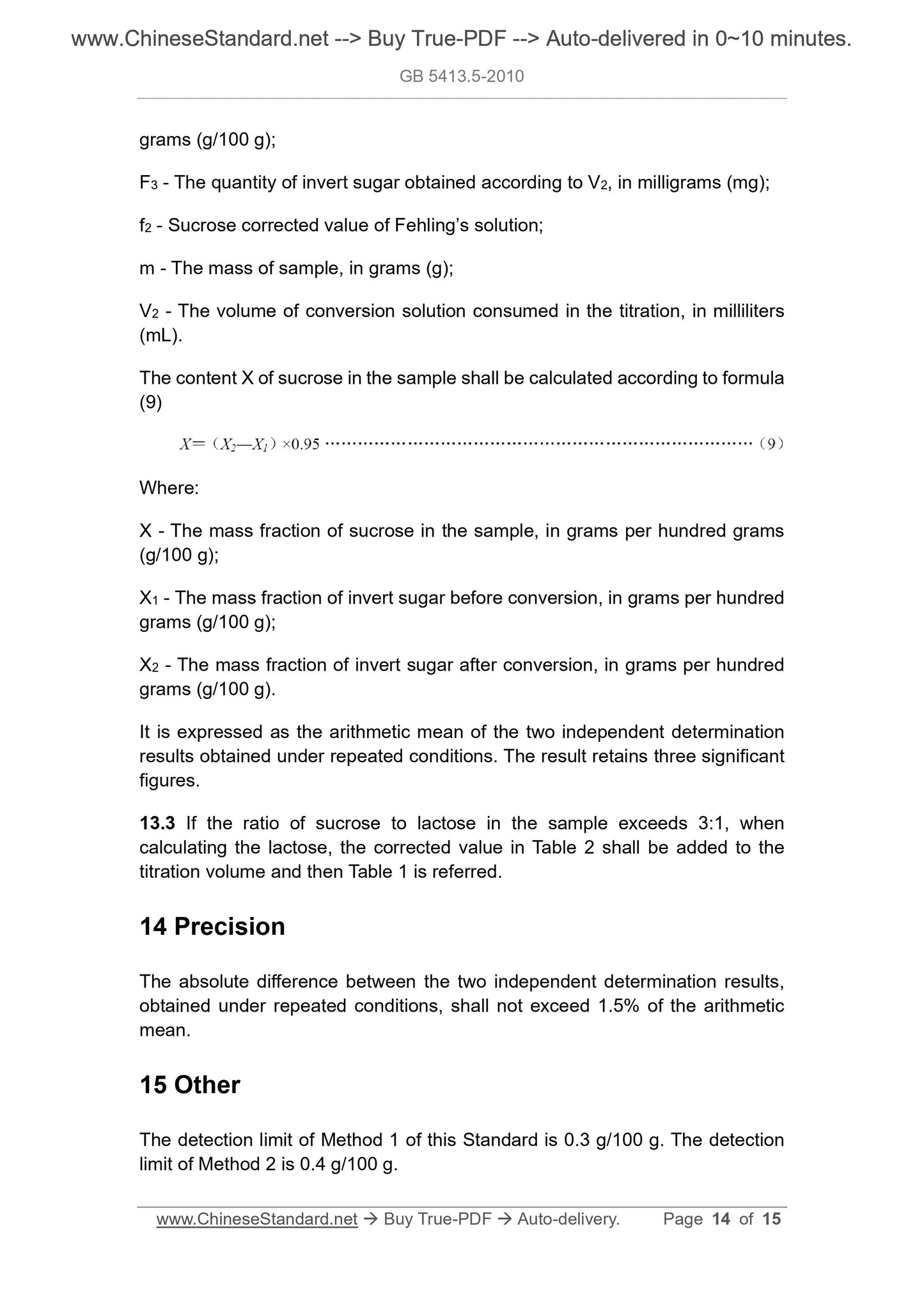1
/
of
7
PayPal, credit cards. Download editable-PDF & invoice in 1 second!
GB 5413.5-2010 English PDF
GB 5413.5-2010 English PDF
Regular price
$70.00 USD
Regular price
Sale price
$70.00 USD
Unit price
/
per
Shipping calculated at checkout.
Couldn't load pickup availability
Delivery: 3 seconds. Download true-PDF + Invoice.
Get Quotation: Click GB 5413.5-2010 (Self-service in 1-minute)
Historical versions (Master-website): GB 5413.5-2010
Preview True-PDF (Reload/Scroll-down if blank)
GB 5413.5-2010: National food safety standard - Determination of lactose and sucrose in foods for infants and young children, milk and milk products
GB 5413.5-2010
National food safety standard. Determination of lactose and sucrose in foods for infants and young children, milk and milk products
GB
NATIONAL STANDARD OF THE
PEOPLE’S REPUBLIC OF CHINA
National food safety standard -
Determination of lactose and sucrose in foods for
infants and young children, milk and milk products
Issued on. March 26, 2010 Implemented on. June 01, 2010
Issued by. Ministry of Health of the People’s Republic of China
Table of Contents
Foreword ...3
1 Scope ...4
2 Normative references ...4
3 Principles ...4
4 Reagents and materials ...4
5 Instruments and apparatuses ...5
6 Analytical procedures ...5
7 Analysis results expression ...6
8 Precision ...7
9 Principles ...7
10 Reagents and materials ...7
11 Instruments and apparatuses ...8
12 Analytical procedures ...9
13 Analysis results expression ...12
14 Precision ...14
15 Other ...14
National food safety standard -
Determination of lactose and sucrose in foods for
infants and young children, milk and milk products
1 Scope
This Standard specifies the method for determination of lactose and sucrose in
foods for infants and young children, milk and milk products.
This Standard applies to the determination of lactose and sucrose in foods for
infants and young children, milk and milk products.
2 Normative references
The documents referenced in this Standard are indispensable for the
application of this Standard.For the dated references, only the editions with the
dates indicated are applicable to this Standard.For the undated references, the
latest edition (including all the amendments) are applicable to this Standard.
Method I -- High performance liquid chromatography
3 Principles
After the lactose and sucrose in the sample are extracted, USE high
performance liquid chromatographic column to separate; USE differential
refractive index detector or evaporative light-scattering detector to detect; USE
external standard method to quantify.
4 Reagents and materials
Unless otherwise specified, the reagents used in this method are analytically
pure; and the water is Grade 1 water specified in GB/T 6682.
4.1 Acetonitrile.
4.2 Acetonitrile. chromatographically pure.
4.3 Standard solutions
4.3.1 Lactose standard stock solution (20 mg/mL). WEIGH 2 g (accurate to 0.1
mg) of the lactose standard sample dried in an oven at 94 °C±2 °C for 2 h;
DISSOLVE in water; USE water to dilute to a 100 mL volumetric flask.PLACE
in a 4 °C refrigerator.
4.3.2 Lactose standard working solutions. separately PIPETTE 0 mL, 1 mL, 2
mL, 3 mL, 4 mL, 5 mL of lactose standard stock solution (4.3.1) in 10 mL
volumetric flasks; USE acetonitrile (4.1) to dilute to mark.The series of lactose
standard working solutions are prepared, at concentrations of 0 mg/mL, 2
mg/mL, 4 mg/mL, 6 mg/mL, 8 mg/mL, 10 mg/mL respectively.
4.3.3 Sucrose standard solution (10 mg/mL). WEIGH 1 g (accurate to 0.1 mg)
of sucrose standard sample dried in an oven at 105 °C±2 °C for 2 h; DISSOLVE
in water; USE water to dilute to a 100mL volumetric flask.PLACE in a 4 °C
refrigerator.
4.3.4 Sucrose standard working solutions. separately PIPETTE 0 mL, 1 mL, 2
mL, 3 mL, 4 mL, 5 mL of sucrose standard solution (4.3.3) in 10 mL volumetric
flasks; USE acetonitrile (4.1) to dilute to mark.The series of sucrose standard
working solutions are prepared, at concentrations of 0 mg/mL, 1 mg/mL, 2
mg/mL, 3 mg/mL, 4 mg/mL, 5 mg/mL respectively.
5 Instruments and apparatuses
5.1 Balance. The sensitivity is 0.1 mg.
5.2 High performance liquid chromatograph, with a differential refractive index
detector or an evaporative light-scattering detector.
5.3 Ultrasonic oscillator.
6 Analytical procedures
6.1 Sample processing
WEIGH 1 g of solid sample or 2.5 g (accurate to 0.1 mg) of liquid sample into a
50 mL volumetric flask; ADD 15 mL of water at 50 °C~60 °C to dissolve; oscillate
in an ultrasonic oscillator for 10 min; USE acetonitrile (4.1) to dilute to mark;
LET it stand for a few minutes, and filter.Take 5.0 mL of the filtrate in a 10 mL
volumetric flask; USE acetonitrile (4.1) to dilute to mark; FILTER through a 0.45
c - The concentration of sugar in the sample solution, in milligrams per milliliter
(mg/mL);
V - Constant volume of sample, in milliliters (mL);
n - Dilution factor of sample solution;
m - Mass of sample, in grams (g).
It is expressed as the arithmetic mean of the two independent determination
results obtained under repeated conditions.The result retains three significant
figures.
8 Precision
The absolute difference between the two independent determination results,
obtained under repeated conditions, shall not exceed 5% of the arithmetic mean.
Method II -- Lane-Eynon’s method
9 Principles
Lactose. After removing the protein from the sample, under the heating
condition, USE the methylene blue as an indicator; the calibrated Fehling’s
solution is directly titrated.According to the volume consumed by the sample
solution, the lactose content is calculated.
Sucrose. After removing the protein from the sample, sucrose is hydrolyzed by
hydrochloric acid to reducing sugar, and then determined by reducing sugar.
The difference before and after hydrolysis multiplied by the corresponding
coefficient is the sucrose content.
10 Reagents and materials
Unless otherwise specified, the reagents used in this method are analytically
pure; and the water is Grade 3 water specified in GB/T 6682.
10.1 Lead acetate.
10.2 Potassium oxalate.
10.3 Disodium hydrogen phosphate.
10.4 Hydrochloric acid.
10.5 Copper sulfate.
10.6 Concentrated sulfuric acid.
10.7 Potassium sodium tartrate.
10.8 Sodium hydroxide.
10.9 Phenolphthalein.
10.10 Ethanol.
10.11 Methylene blue.
10.12 Lead acetate solution (200 g/L). WEIGH 200 g of lead acetate;
DISSOLVE in water and dilute to 1000 mL.
10.13 Potassium oxalate-disodium hydrogen phosphate solution. WEIGH 30 g
of potassium oxalate, 70 g of disodium hydrogen phosphate; DISSOLVE in
water and dilute to 1000 mL.
10.14 Hydrochloric acid (1+1). 1 volume of hydrochloric acid is mixed with 1
volume of water.
10.15 Sodium hydroxide solution (300 g/L). WEIGH 300 g of sodium hydroxide;
DISSOLVE in water and dilute to 1000 mL.
10.16 Fehling’s solution (solution A and solution B)
10.16.1 Solution A. WEIGH 34.639 g of copper sulfate dissolved in water; ADD
0.5 mL of concentrated sulfuric acid; ADD water to 500 mL.
10.16.2 Solution B. WEIGH 173 g of potassium sodium tartrate and 50 g of
sodium hydroxide dissolved in water; DILUTE to 500 mL; LET stand for two
days and filter.
10.17 Phenolphthalein solution (5 g/L). WEIGH 0.5 g of phenolphthalein in 100
mL of ethanol with a volume fraction of 95%.
10.18 Methylene blue solution (10 g/L). WEIGH 1 g of methylene blue in 100
mL of water.
11 Instruments and apparatuses
11.1 Balance. The sensitivity is 0.1 mg.
AL2 - The quantity of invert sugar obtained in Table 1 according to milliliter
number of sucrose solution for titration, in milligrams (mg).
12.2 Determination of lactose
12.2.1 Sample processing
12.2.1.1 WEIGH 2 g of infant food or skim powder, 2.5 g of whole sugared
powder or whole powder, 1 g of whey powder, accurate to 0.1 mg.USE 100 mL
of water to dissolve several times and WASH into a 250 mL volumetric flask.
12.2.1.2 Slowly ADD 4 mL of lead acetate solution (10.12), 4 mL of potassium
oxalate-disodium hydrogen phosphate solution (10.13); and oscillate the
volumetric flask; USE water to dilute to mark.LET stand for a few minutes; USE
a dry filter paper to filter.After discarding the first 25 mL of the filtrate, the
obtained filtrate is titrated.
12.2.2 Titration
12.2.2.1 Pre-titration. The operation is the same as 12.1.1.2.
12.2.2.2 Precise titration. The operation is the same as 12.1.1.3.
12.3 Determination of sucrose
12.3.1 Conversion and titration of sample solution
TAKE 50 mL of sample solution (12.2.1.2) in a 100 mL volumetric flask.The
subsequent operation is carried out according to 12.1.2.1 from “ADD 10 mL of
water”.
13 Analysis results expression
13.1 Lactose
The content X of lactose in the sample shall be calculated according to formula
(6)
Where.
X - The mass fraction of lactose in the sample, in grams per hundred grams
(g/100 g);
grams (g/100 g);
F3 - The quantity of invert sugar obtained according to V2, in milligrams (mg);
f2 - Sucrose corrected value of Fehling’s solution;
m - The mass of sample, in grams (g);
V2 - The volume of conversion solution consumed in the titration, in milliliters
(mL).
The content X of sucrose in the sample shall be calculated according to formula
(9)
Where.
X - The mass fraction of sucrose in the sample, in grams per hundred grams
(g/100 g);
X1 - The mass fraction of invert sugar before conversion, in grams per hundred
grams (g/100 g);
X2 - The mass fraction of invert sugar after conversion, in grams per hundred
grams (g/100 g).
It is expressed as the arithmetic mean of the two independent determination
results obtained under repeated conditions.The result retains three significant
figures.
13.3 If the ratio of sucrose to lactose in the sample exceeds 3.1, when
calculating the lactose, the corrected value in Table 2 shall be added to the
titration volume and then Table 1 is referred.
14 Precision
The absolute difference between the two independent determination results,
obtained under repeated conditions, shall not exceed 1.5% of the arithmetic
mean.
15 Other
The detection limit of Method 1 of this Standard is 0.3 g/100 g.The detection
limit of Method 2 is 0.4 g/100 g.
GB 5413.5-2010
National food safety standard. Determination of lactose and sucrose in foods for infants and young children, milk and milk products
GB
NATIONAL STANDARD OF THE
PEOPLE’S REPUBLIC OF CHINA
National food safety standard -
Determination of lactose and sucrose in foods for
infants and young children, milk and milk products
Issued on. March 26, 2010 Implemented on. June 01, 2010
Issued by. Ministry of Health of the People’s Republic of China
Table of Contents
Foreword ...3
1 Scope ...4
2 Normative references ...4
3 Principles ...4
4 Reagents and materials ...4
5 Instruments and apparatuses ...5
6 Analytical procedures ...5
7 Analysis results expression ...6
8 Precision ...7
9 Principles ...7
10 Reagents and materials ...7
11 Instruments and apparatuses ...8
12 Analytical procedures ...9
13 Analysis results expression ...12
14 Precision ...14
15 Other ...14
National food safety standard -
Determination of lactose and sucrose in foods for
infants and young children, milk and milk products
1 Scope
This Standard specifies the method for determination of lactose and sucrose in
foods for infants and young children, milk and milk products.
This Standard applies to the determination of lactose and sucrose in foods for
infants and young children, milk and milk products.
2 Normative references
The documents referenced in this Standard are indispensable for the
application of this Standard.For the dated references, only the editions with the
dates indicated are applicable to this Standard.For the undated references, the
latest edition (including all the amendments) are applicable to this Standard.
Method I -- High performance liquid chromatography
3 Principles
After the lactose and sucrose in the sample are extracted, USE high
performance liquid chromatographic column to separate; USE differential
refractive index detector or evaporative light-scattering detector to detect; USE
external standard method to quantify.
4 Reagents and materials
Unless otherwise specified, the reagents used in this method are analytically
pure; and the water is Grade 1 water specified in GB/T 6682.
4.1 Acetonitrile.
4.2 Acetonitrile. chromatographically pure.
4.3 Standard solutions
4.3.1 Lactose standard stock solution (20 mg/mL). WEIGH 2 g (accurate to 0.1
mg) of the lactose standard sample dried in an oven at 94 °C±2 °C for 2 h;
DISSOLVE in water; USE water to dilute to a 100 mL volumetric flask.PLACE
in a 4 °C refrigerator.
4.3.2 Lactose standard working solutions. separately PIPETTE 0 mL, 1 mL, 2
mL, 3 mL, 4 mL, 5 mL of lactose standard stock solution (4.3.1) in 10 mL
volumetric flasks; USE acetonitrile (4.1) to dilute to mark.The series of lactose
standard working solutions are prepared, at concentrations of 0 mg/mL, 2
mg/mL, 4 mg/mL, 6 mg/mL, 8 mg/mL, 10 mg/mL respectively.
4.3.3 Sucrose standard solution (10 mg/mL). WEIGH 1 g (accurate to 0.1 mg)
of sucrose standard sample dried in an oven at 105 °C±2 °C for 2 h; DISSOLVE
in water; USE water to dilute to a 100mL volumetric flask.PLACE in a 4 °C
refrigerator.
4.3.4 Sucrose standard working solutions. separately PIPETTE 0 mL, 1 mL, 2
mL, 3 mL, 4 mL, 5 mL of sucrose standard solution (4.3.3) in 10 mL volumetric
flasks; USE acetonitrile (4.1) to dilute to mark.The series of sucrose standard
working solutions are prepared, at concentrations of 0 mg/mL, 1 mg/mL, 2
mg/mL, 3 mg/mL, 4 mg/mL, 5 mg/mL respectively.
5 Instruments and apparatuses
5.1 Balance. The sensitivity is 0.1 mg.
5.2 High performance liquid chromatograph, with a differential refractive index
detector or an evaporative light-scattering detector.
5.3 Ultrasonic oscillator.
6 Analytical procedures
6.1 Sample processing
WEIGH 1 g of solid sample or 2.5 g (accurate to 0.1 mg) of liquid sample into a
50 mL volumetric flask; ADD 15 mL of water at 50 °C~60 °C to dissolve; oscillate
in an ultrasonic oscillator for 10 min; USE acetonitrile (4.1) to dilute to mark;
LET it stand for a few minutes, and filter.Take 5.0 mL of the filtrate in a 10 mL
volumetric flask; USE acetonitrile (4.1) to dilute to mark; FILTER through a 0.45
c - The concentration of sugar in the sample solution, in milligrams p...
Get Quotation: Click GB 5413.5-2010 (Self-service in 1-minute)
Historical versions (Master-website): GB 5413.5-2010
Preview True-PDF (Reload/Scroll-down if blank)
GB 5413.5-2010: National food safety standard - Determination of lactose and sucrose in foods for infants and young children, milk and milk products
GB 5413.5-2010
National food safety standard. Determination of lactose and sucrose in foods for infants and young children, milk and milk products
GB
NATIONAL STANDARD OF THE
PEOPLE’S REPUBLIC OF CHINA
National food safety standard -
Determination of lactose and sucrose in foods for
infants and young children, milk and milk products
Issued on. March 26, 2010 Implemented on. June 01, 2010
Issued by. Ministry of Health of the People’s Republic of China
Table of Contents
Foreword ...3
1 Scope ...4
2 Normative references ...4
3 Principles ...4
4 Reagents and materials ...4
5 Instruments and apparatuses ...5
6 Analytical procedures ...5
7 Analysis results expression ...6
8 Precision ...7
9 Principles ...7
10 Reagents and materials ...7
11 Instruments and apparatuses ...8
12 Analytical procedures ...9
13 Analysis results expression ...12
14 Precision ...14
15 Other ...14
National food safety standard -
Determination of lactose and sucrose in foods for
infants and young children, milk and milk products
1 Scope
This Standard specifies the method for determination of lactose and sucrose in
foods for infants and young children, milk and milk products.
This Standard applies to the determination of lactose and sucrose in foods for
infants and young children, milk and milk products.
2 Normative references
The documents referenced in this Standard are indispensable for the
application of this Standard.For the dated references, only the editions with the
dates indicated are applicable to this Standard.For the undated references, the
latest edition (including all the amendments) are applicable to this Standard.
Method I -- High performance liquid chromatography
3 Principles
After the lactose and sucrose in the sample are extracted, USE high
performance liquid chromatographic column to separate; USE differential
refractive index detector or evaporative light-scattering detector to detect; USE
external standard method to quantify.
4 Reagents and materials
Unless otherwise specified, the reagents used in this method are analytically
pure; and the water is Grade 1 water specified in GB/T 6682.
4.1 Acetonitrile.
4.2 Acetonitrile. chromatographically pure.
4.3 Standard solutions
4.3.1 Lactose standard stock solution (20 mg/mL). WEIGH 2 g (accurate to 0.1
mg) of the lactose standard sample dried in an oven at 94 °C±2 °C for 2 h;
DISSOLVE in water; USE water to dilute to a 100 mL volumetric flask.PLACE
in a 4 °C refrigerator.
4.3.2 Lactose standard working solutions. separately PIPETTE 0 mL, 1 mL, 2
mL, 3 mL, 4 mL, 5 mL of lactose standard stock solution (4.3.1) in 10 mL
volumetric flasks; USE acetonitrile (4.1) to dilute to mark.The series of lactose
standard working solutions are prepared, at concentrations of 0 mg/mL, 2
mg/mL, 4 mg/mL, 6 mg/mL, 8 mg/mL, 10 mg/mL respectively.
4.3.3 Sucrose standard solution (10 mg/mL). WEIGH 1 g (accurate to 0.1 mg)
of sucrose standard sample dried in an oven at 105 °C±2 °C for 2 h; DISSOLVE
in water; USE water to dilute to a 100mL volumetric flask.PLACE in a 4 °C
refrigerator.
4.3.4 Sucrose standard working solutions. separately PIPETTE 0 mL, 1 mL, 2
mL, 3 mL, 4 mL, 5 mL of sucrose standard solution (4.3.3) in 10 mL volumetric
flasks; USE acetonitrile (4.1) to dilute to mark.The series of sucrose standard
working solutions are prepared, at concentrations of 0 mg/mL, 1 mg/mL, 2
mg/mL, 3 mg/mL, 4 mg/mL, 5 mg/mL respectively.
5 Instruments and apparatuses
5.1 Balance. The sensitivity is 0.1 mg.
5.2 High performance liquid chromatograph, with a differential refractive index
detector or an evaporative light-scattering detector.
5.3 Ultrasonic oscillator.
6 Analytical procedures
6.1 Sample processing
WEIGH 1 g of solid sample or 2.5 g (accurate to 0.1 mg) of liquid sample into a
50 mL volumetric flask; ADD 15 mL of water at 50 °C~60 °C to dissolve; oscillate
in an ultrasonic oscillator for 10 min; USE acetonitrile (4.1) to dilute to mark;
LET it stand for a few minutes, and filter.Take 5.0 mL of the filtrate in a 10 mL
volumetric flask; USE acetonitrile (4.1) to dilute to mark; FILTER through a 0.45
c - The concentration of sugar in the sample solution, in milligrams per milliliter
(mg/mL);
V - Constant volume of sample, in milliliters (mL);
n - Dilution factor of sample solution;
m - Mass of sample, in grams (g).
It is expressed as the arithmetic mean of the two independent determination
results obtained under repeated conditions.The result retains three significant
figures.
8 Precision
The absolute difference between the two independent determination results,
obtained under repeated conditions, shall not exceed 5% of the arithmetic mean.
Method II -- Lane-Eynon’s method
9 Principles
Lactose. After removing the protein from the sample, under the heating
condition, USE the methylene blue as an indicator; the calibrated Fehling’s
solution is directly titrated.According to the volume consumed by the sample
solution, the lactose content is calculated.
Sucrose. After removing the protein from the sample, sucrose is hydrolyzed by
hydrochloric acid to reducing sugar, and then determined by reducing sugar.
The difference before and after hydrolysis multiplied by the corresponding
coefficient is the sucrose content.
10 Reagents and materials
Unless otherwise specified, the reagents used in this method are analytically
pure; and the water is Grade 3 water specified in GB/T 6682.
10.1 Lead acetate.
10.2 Potassium oxalate.
10.3 Disodium hydrogen phosphate.
10.4 Hydrochloric acid.
10.5 Copper sulfate.
10.6 Concentrated sulfuric acid.
10.7 Potassium sodium tartrate.
10.8 Sodium hydroxide.
10.9 Phenolphthalein.
10.10 Ethanol.
10.11 Methylene blue.
10.12 Lead acetate solution (200 g/L). WEIGH 200 g of lead acetate;
DISSOLVE in water and dilute to 1000 mL.
10.13 Potassium oxalate-disodium hydrogen phosphate solution. WEIGH 30 g
of potassium oxalate, 70 g of disodium hydrogen phosphate; DISSOLVE in
water and dilute to 1000 mL.
10.14 Hydrochloric acid (1+1). 1 volume of hydrochloric acid is mixed with 1
volume of water.
10.15 Sodium hydroxide solution (300 g/L). WEIGH 300 g of sodium hydroxide;
DISSOLVE in water and dilute to 1000 mL.
10.16 Fehling’s solution (solution A and solution B)
10.16.1 Solution A. WEIGH 34.639 g of copper sulfate dissolved in water; ADD
0.5 mL of concentrated sulfuric acid; ADD water to 500 mL.
10.16.2 Solution B. WEIGH 173 g of potassium sodium tartrate and 50 g of
sodium hydroxide dissolved in water; DILUTE to 500 mL; LET stand for two
days and filter.
10.17 Phenolphthalein solution (5 g/L). WEIGH 0.5 g of phenolphthalein in 100
mL of ethanol with a volume fraction of 95%.
10.18 Methylene blue solution (10 g/L). WEIGH 1 g of methylene blue in 100
mL of water.
11 Instruments and apparatuses
11.1 Balance. The sensitivity is 0.1 mg.
AL2 - The quantity of invert sugar obtained in Table 1 according to milliliter
number of sucrose solution for titration, in milligrams (mg).
12.2 Determination of lactose
12.2.1 Sample processing
12.2.1.1 WEIGH 2 g of infant food or skim powder, 2.5 g of whole sugared
powder or whole powder, 1 g of whey powder, accurate to 0.1 mg.USE 100 mL
of water to dissolve several times and WASH into a 250 mL volumetric flask.
12.2.1.2 Slowly ADD 4 mL of lead acetate solution (10.12), 4 mL of potassium
oxalate-disodium hydrogen phosphate solution (10.13); and oscillate the
volumetric flask; USE water to dilute to mark.LET stand for a few minutes; USE
a dry filter paper to filter.After discarding the first 25 mL of the filtrate, the
obtained filtrate is titrated.
12.2.2 Titration
12.2.2.1 Pre-titration. The operation is the same as 12.1.1.2.
12.2.2.2 Precise titration. The operation is the same as 12.1.1.3.
12.3 Determination of sucrose
12.3.1 Conversion and titration of sample solution
TAKE 50 mL of sample solution (12.2.1.2) in a 100 mL volumetric flask.The
subsequent operation is carried out according to 12.1.2.1 from “ADD 10 mL of
water”.
13 Analysis results expression
13.1 Lactose
The content X of lactose in the sample shall be calculated according to formula
(6)
Where.
X - The mass fraction of lactose in the sample, in grams per hundred grams
(g/100 g);
grams (g/100 g);
F3 - The quantity of invert sugar obtained according to V2, in milligrams (mg);
f2 - Sucrose corrected value of Fehling’s solution;
m - The mass of sample, in grams (g);
V2 - The volume of conversion solution consumed in the titration, in milliliters
(mL).
The content X of sucrose in the sample shall be calculated according to formula
(9)
Where.
X - The mass fraction of sucrose in the sample, in grams per hundred grams
(g/100 g);
X1 - The mass fraction of invert sugar before conversion, in grams per hundred
grams (g/100 g);
X2 - The mass fraction of invert sugar after conversion, in grams per hundred
grams (g/100 g).
It is expressed as the arithmetic mean of the two independent determination
results obtained under repeated conditions.The result retains three significant
figures.
13.3 If the ratio of sucrose to lactose in the sample exceeds 3.1, when
calculating the lactose, the corrected value in Table 2 shall be added to the
titration volume and then Table 1 is referred.
14 Precision
The absolute difference between the two independent determination results,
obtained under repeated conditions, shall not exceed 1.5% of the arithmetic
mean.
15 Other
The detection limit of Method 1 of this Standard is 0.3 g/100 g.The detection
limit of Method 2 is 0.4 g/100 g.
GB 5413.5-2010
National food safety standard. Determination of lactose and sucrose in foods for infants and young children, milk and milk products
GB
NATIONAL STANDARD OF THE
PEOPLE’S REPUBLIC OF CHINA
National food safety standard -
Determination of lactose and sucrose in foods for
infants and young children, milk and milk products
Issued on. March 26, 2010 Implemented on. June 01, 2010
Issued by. Ministry of Health of the People’s Republic of China
Table of Contents
Foreword ...3
1 Scope ...4
2 Normative references ...4
3 Principles ...4
4 Reagents and materials ...4
5 Instruments and apparatuses ...5
6 Analytical procedures ...5
7 Analysis results expression ...6
8 Precision ...7
9 Principles ...7
10 Reagents and materials ...7
11 Instruments and apparatuses ...8
12 Analytical procedures ...9
13 Analysis results expression ...12
14 Precision ...14
15 Other ...14
National food safety standard -
Determination of lactose and sucrose in foods for
infants and young children, milk and milk products
1 Scope
This Standard specifies the method for determination of lactose and sucrose in
foods for infants and young children, milk and milk products.
This Standard applies to the determination of lactose and sucrose in foods for
infants and young children, milk and milk products.
2 Normative references
The documents referenced in this Standard are indispensable for the
application of this Standard.For the dated references, only the editions with the
dates indicated are applicable to this Standard.For the undated references, the
latest edition (including all the amendments) are applicable to this Standard.
Method I -- High performance liquid chromatography
3 Principles
After the lactose and sucrose in the sample are extracted, USE high
performance liquid chromatographic column to separate; USE differential
refractive index detector or evaporative light-scattering detector to detect; USE
external standard method to quantify.
4 Reagents and materials
Unless otherwise specified, the reagents used in this method are analytically
pure; and the water is Grade 1 water specified in GB/T 6682.
4.1 Acetonitrile.
4.2 Acetonitrile. chromatographically pure.
4.3 Standard solutions
4.3.1 Lactose standard stock solution (20 mg/mL). WEIGH 2 g (accurate to 0.1
mg) of the lactose standard sample dried in an oven at 94 °C±2 °C for 2 h;
DISSOLVE in water; USE water to dilute to a 100 mL volumetric flask.PLACE
in a 4 °C refrigerator.
4.3.2 Lactose standard working solutions. separately PIPETTE 0 mL, 1 mL, 2
mL, 3 mL, 4 mL, 5 mL of lactose standard stock solution (4.3.1) in 10 mL
volumetric flasks; USE acetonitrile (4.1) to dilute to mark.The series of lactose
standard working solutions are prepared, at concentrations of 0 mg/mL, 2
mg/mL, 4 mg/mL, 6 mg/mL, 8 mg/mL, 10 mg/mL respectively.
4.3.3 Sucrose standard solution (10 mg/mL). WEIGH 1 g (accurate to 0.1 mg)
of sucrose standard sample dried in an oven at 105 °C±2 °C for 2 h; DISSOLVE
in water; USE water to dilute to a 100mL volumetric flask.PLACE in a 4 °C
refrigerator.
4.3.4 Sucrose standard working solutions. separately PIPETTE 0 mL, 1 mL, 2
mL, 3 mL, 4 mL, 5 mL of sucrose standard solution (4.3.3) in 10 mL volumetric
flasks; USE acetonitrile (4.1) to dilute to mark.The series of sucrose standard
working solutions are prepared, at concentrations of 0 mg/mL, 1 mg/mL, 2
mg/mL, 3 mg/mL, 4 mg/mL, 5 mg/mL respectively.
5 Instruments and apparatuses
5.1 Balance. The sensitivity is 0.1 mg.
5.2 High performance liquid chromatograph, with a differential refractive index
detector or an evaporative light-scattering detector.
5.3 Ultrasonic oscillator.
6 Analytical procedures
6.1 Sample processing
WEIGH 1 g of solid sample or 2.5 g (accurate to 0.1 mg) of liquid sample into a
50 mL volumetric flask; ADD 15 mL of water at 50 °C~60 °C to dissolve; oscillate
in an ultrasonic oscillator for 10 min; USE acetonitrile (4.1) to dilute to mark;
LET it stand for a few minutes, and filter.Take 5.0 mL of the filtrate in a 10 mL
volumetric flask; USE acetonitrile (4.1) to dilute to mark; FILTER through a 0.45
c - The concentration of sugar in the sample solution, in milligrams p...
Share
